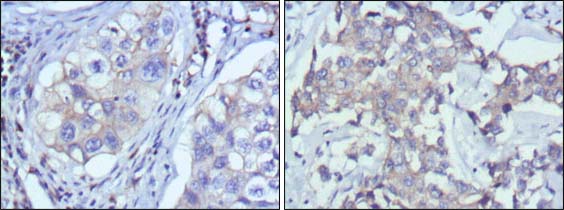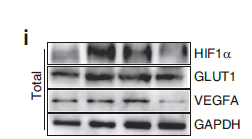
主要信息
Target
Rtn-3
Host Species
Mouse
Reactivity
Human
Applications
IHC, IF, ELISA
Conjugate/Modification
Unmodified
货号: YM0567
规格
价格
货期
数量
200μL
¥5,880.00
一周
0
100μL
¥3,200.00
一周
0
50μL
¥2,000.00
一周
0
加入购物车


已收藏


收藏
详细信息
推荐稀释比
IHC 1:200-1:1000; ELISA 1:10000; IF 1:50-200
组成
Liquid in PBS containing 50% glycerol, 0.5% BSA and 0.02% sodium azide.
特异性
Rtn-3 Monoclonal Antibody detects endogenous levels of Rtn-3 protein.
纯化工艺
Affinity purification
储存
-15°C to -25°C/1 year(Do not lower than -25°C)
修饰
Unmodified
克隆性
Monoclonal
相关产品
抗原&靶点信息
免疫原:
Purified recombinant fragment of Rtn-3 expressed in E. Coli.
展开内容
特异性:
Rtn-3 Monoclonal Antibody detects endogenous levels of Rtn-3 protein.
展开内容
基因名称:
RTN3
展开内容
蛋白名称:
Reticulon-3
展开内容
别名:
RTN3 ;
ASYIP ;
NSPL2 ;
Reticulon-3 ;
Neuroendocrine-specific protein-like 2 ;
NSP-like protein 2 ;
Neuroendocrine-specific protein-like II ;
NSP-like protein II ;
NSPLII
ASYIP ;
NSPL2 ;
Reticulon-3 ;
Neuroendocrine-specific protein-like 2 ;
NSP-like protein 2 ;
Neuroendocrine-specific protein-like II ;
NSP-like protein II ;
NSPLII
展开内容
背景:
This gene belongs to the reticulon family of highly conserved genes that are preferentially expressed in neuroendocrine tissues. This family of proteins interact with, and modulate the activity of beta-amyloid converting enzyme 1 (BACE1), and the production of amyloid-beta. An increase in the expression of any reticulon protein substantially reduces the production of amyloid-beta, suggesting that reticulon proteins are negative modulators of BACE1 in cells. Alternatively spliced transcript variants encoding different isoforms have been found for this gene, and pseudogenes of this gene are located on chromosomes 4 and 12. [provided by RefSeq, May 2012],
展开内容
功能:
Function:May be involved in membrane trafficking in the early secretory pathway. Inhibits BACE1 activity and amyloid precursor protein processing. May induce caspase-8 cascade and apoptosis. May favor BCL2 translocation to the mitochondria upon endoplasmic reticulum stress. In case of enteroviruses infection, RTN3 may be involved in the viral replication or pathogenesis.,induction:By endoplasmic reticulum stress (at protein level).,miscellaneous:The sequence shown here is derived from an EMBL/GenBank/DDBJ third party annotation (TPA) entry.,similarity:Contains 1 reticulon domain.,subunit:Homodimer. Interacts with RTN4. Isoform 3 interacts with BACE1, BACE2, BCL2 and FADD. Interacts with Coxsackievirus A16, enterovirus 71 and poliovirus P2C proteins.,tissue specificity:Isoform 3 is widely expressed, with highest levels in brain, where it is enriched in neuronal cell bodies from gray matter (at protein level). Three times more abundant in macula than in peripheral retina. Isoform 1 is expressed at high levels in brain and at low levels in skeletal muscle. Isoform 2 is only found in melanoma.,
展开内容
细胞定位:
Endoplasmic reticulum membrane ; Multi-pass membrane protein . Golgi apparatus membrane ; Multi-pass membrane protein .
展开内容
组织表达:
Isoform 3 is widely expressed, with highest levels in brain, where it is enriched in neuronal cell bodies from gray matter (at protein level). Three times more abundant in macula than in peripheral retina. Isoform 1 is expressed at high levels in brain and at low levels in skeletal muscle. Isoform 2 is only found in melanoma.
展开内容
研究领域:
>>Alzheimer disease
展开内容
文献引用({{totalcount}})
货号: YM0567
规格
价格
货期
数量
200μL
¥5,880.00
一周
0
100μL
¥3,200.00
一周
0
50μL
¥2,000.00
一周
0
加入购物车


已收藏


收藏
Recently Viewed Products
Clear allToggle night Mode
{{pinfoXq.title || ''}}
Catalog: {{pinfoXq.catalog || ''}}
Filter:
All
{{item.name}}
{{pinfo.title}}
-{{pinfo.catalog}}
主要信息
Target
{{pinfo.target}}
Reactivity
{{pinfo.react}}
Applications
{{pinfo.applicat}}
Conjugate/Modification
{{pinfo.coupling}}/{{pinfo.modific}}
MW (kDa)
{{pinfo.mwcalc}}
Host Species
{{pinfo.hostspec}}
Isotype
{{pinfo.isotype}}
产品 {{index}}/{{pcount}}
上一个产品
下一个产品
{{pvTitle}}
滚轮缩放图片
{{pvDescr}}





















